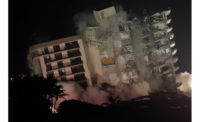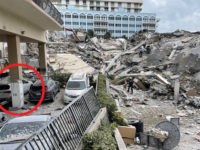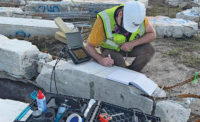Failures
Engineers Piece Together Champlain Towers Probable Collapse Sequence
The trigger for the progressive collapse of the condo tower in South Florida remains a mystery

This aerial view taken while search and rescue personnel worked on the debris pile shows the basic footprint of the Champlain Towers South collapse site in Surfside, north of Miami Beach.
Photo by CHANDAN KHANNA/AFP via Getty Images.
Thanks to a surveillance video, photos, a 2018 building-system survey and the original 1979 plans, structural engineers have pieced together the probable sequence of the fatal progressive collapse of part of the 12.5-story Champlain Towers South residential condominium, north of Miami Beach in Surfside, Fla. But the initiating event on June 24 that brought down a wing, about 150 ft long, of the 40-year-old reinforced concrete structure remains a mystery.
“I’m trying to find the trigger,” says Allyn Kilsheimer, founder, president and CEO of KCE Structural Engineers, who is investigating the collapse for the town of Surfside.
The start of the deadly event, which killed at least 11 people and left 150 still missing, “seems to be near the base … but there are lots of questions,” Kilsheimer adds.
The surveillance video from a nearby building that has been widely studied starts a few seconds into the collapse. Kilsheimer, at the site since June 25, says he hopes other videos will surface, including one that shows the very beginning of the collapse. “That one video [we have] doesn’t give you a 3D view of the building,” he says.

The wing of the residential building still left standing, looking from the east. The shear wall of the elevator-stair tower is in the center of the photo.
Photo by: Jeff Greenberg/Universal Images Group via Getty Images
Reinforced Concrete with Flat Plate Slabs
The reinforced concrete building has flat-plate floor slabs. Flat plates are relatively thin concrete slabs supported directly on columns. The building is lightly braced by shear walls.
The video shows that the failure occurred lower down in the central south-facing perimeter of the building, which is a fat L in plan. The failed long leg of the L extended east to west on the north side of the footprint. “It is possible the failure started higher up in the building on the interior and cascaded downward but it is not visible in the video,” says Jack Moehle, a professor of structural engineering at the University of California, Berkeley.
The video also shows a “very rapid vertical collapse of the interior portion of the building, with relatively little apparent side sway,” says Moehle.
The north side of the long leg followed the south side collapse, almost immediately. “That is apparent from the video,” says Glenn Bell, a forensic structural engineer and director of Collaborative Reporting for Safer Structures (CROSS-US), a division of the American Society of Civil Engineers' Structural Engineering Institute.
Next, the east end of the building, nearest the Atlantic Ocean, got pulled toward the midsection to its west.
The video shows the east end standing for a short while after the midsection collapsed, gradually leaning toward the midsection. Likely there was an imbalanced load due to loss of support from the portion of the building that collapsed, which dragged the remaining portion sideways until its gravity load-carrying capacity was exhausted and it also collapsed, says Bell. In the second part of the collapse, the floors are a little offset from one another because of this effect, he adds.
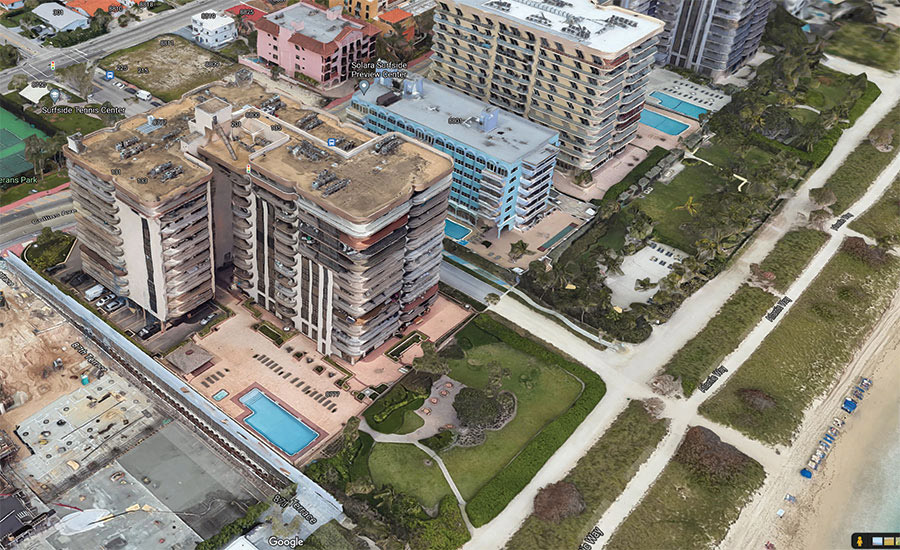
Champlain Towers South was finished in 1981. One failure theory is that there may have been a problem with the elevated pool deck slab near the crook of the L-in-plan building.
Imagery © 2021 Data SIO, NOAA, U.S. Navy, NGA, GEBCO, IBCAO, Landsat / Copernicus, Google, Imagery © 2021 Maxar Technologies, Map data © 2021
Shorter Wing Left Standing
The failure stopped at the west end of the midsection, near where the two legs of the L join, leaving the shorter leg of the L standing. The break was cleaner along the elevator and stair core on the southwest edge of the collapsed section, where there is a shear wall, says Bell.
“There are lots of theories circulating about the trigger,” adds Bell.
Some observers, who have studied the collapse video and photos, the 2018 field survey report by structural engineer Frank P. Morabito and the original 1979 plans by William M. Friedman and Associates Architects Inc. have pointed to distress in the pool deck at the base of the area on the south side of the midsection.
The deck sits over the one-level-basement parking garage, which fills the entire site, including and beyond the building’s footprint. The structural engineer for the development was Breiterman Jurado & Associates.
The theory is that the pool deck’s concrete slab may have failed, possibly because of deteriorated waterproofing, says Bell.
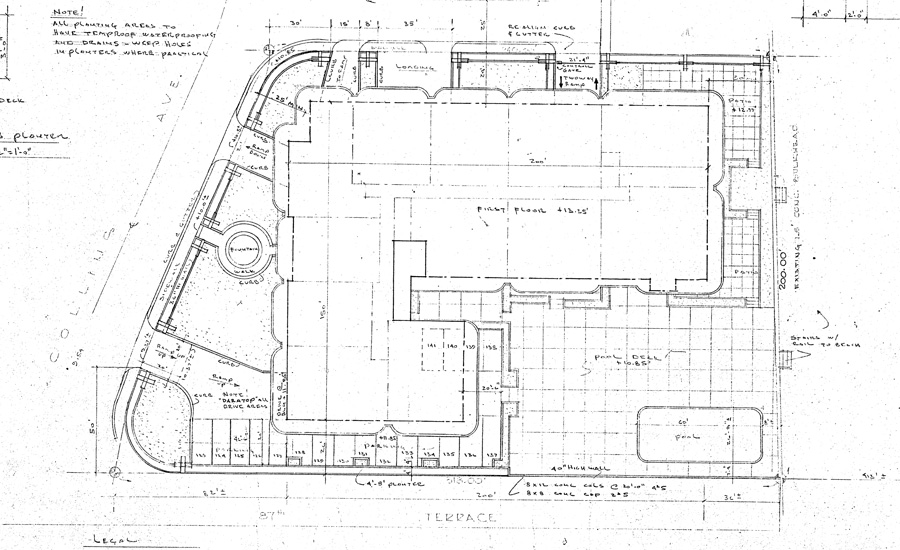
The failed north wing, the longer leg of the L building plan, is shown at the top of the site plan. The section remaining runs north-south, on the west side of the building.
Courtesy of Town of Surfside
Repair Estimate
In his report to the Champlain Towers condo association, Morabito estimated the price of needed repairs at $9.1 million. The estimate for remediating the garage, the entrance and pool deck was the most expensive line item, with a cost of roughly $3.8 million. Remediation of the building’s façade would require an additional $3.2 million, according to Morabito. The repairs, which were planned for 2021 back in 2018, had just begun when the collapse occurred.
There are at least three theories about the trigger of the progressive collapse, beyond the pool deck slab: column failure, slab failure due to punching shear or failure of the pile foundation system, perhaps under the pool deck. Kilsheimer, Bell and others speculate there may have been more than one contributing factor, as in a perfect storm.
Progressive failure is caused either by columns that fail axially due to axial over-stress or shear damage that progresses to axial failure or punching shear failure, says Moehle.
In punching shear, one or more of the building’s flat slabs develops a shear failure around the column and drops relative to the column.
If there is no continuous bottom reinforcement in the slab passing over the columns—a detail not required in 1981—then the slab can move downward relative to the column, redistributing load to adjacent slab-column connections, which in turn can fail. A slab that eventually lands on the floor below it overloads that floor system, and there is more punching shear, says Moehle, who has done extensive testing of concrete structures.
If the columns were the trigger, then it is likely but not certain that the collapse started at the bottom of the building where the axial loads are largest, adds Moehle. If it was the slab-column connection, then the failure could have started just about anywhere in the building and progressed downward in a vertical collapse that extended across the floor and down to the base.

Circled area in photo shows a column with rebar hanging out like hair strands, missing its slab after the slab crashed down, vehicles and all, to the floor below it due to punching shear. The view of the debris pile is from the south looking north.
Original photo courtesy of Miami-Dade Fire Rescue
Some photos of the debris suggest that the collapse involved, at least as a secondary mechanism, punching shear failures. “This could have been a secondary aspect of the collapse, with the primary cause of the collapse being something else,” says Moehle, who adds that his observations are “very preliminary speculation.”
Other possible contributing factors: It is “plausible” that sea spray over 40 years increased the chloride content of the concrete, which, after reaching a critical point, starts corrosion of the rebar, adds Moehle. There could have been a more recent acceleration of corrosion, which accelerated the loss of column strength.
One area of the pool deck simply ended up a level down, columns and all, with no sign of punching shear. It is possible that the pile foundations under that area sank because of the opening up of sinkhole or some other factor. The lowered deck could then have pulled down the rest of the structure.
Another theory is that differential settlement across the footprint of the building can cause the redistribution of internal forces and can over-stress some members.
“It will be a long time before this has been thoroughly studied and thoughtfully considered” to give engineers the confidence to draw lessons about what happened, says Moehle.
ENR Editor Scott Judy contributed reporting for this article.



